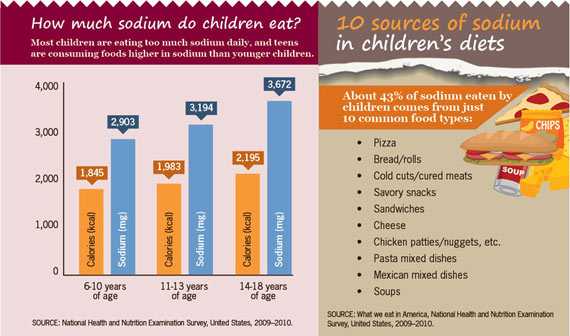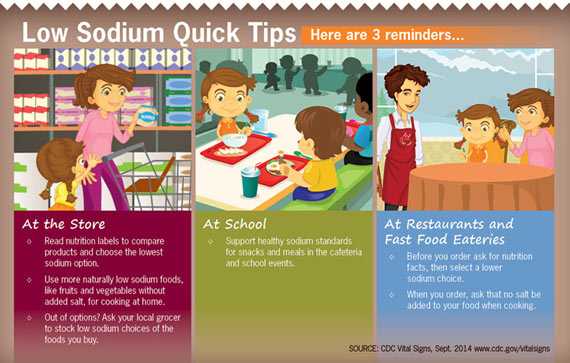Reducing Sodium in Children's Diets
The pressure is on to keep blood pressure down.
September 2014


 90%
90%
About 90% of US children ages 6-18 years eat too much sodium daily.
 10
10
10 common types of foods contributed more than 40% of the sodium eaten by children.
 1 in 6
1 in 6
1 in 6 children has raised blood pressure, which can be lowered in part by a healthy diet, including less sodium.
About 9 in 10 US children eat more sodium than recommended. Most sodium is in the form of salt, as a part of processed foods. A high sodium diet can lead to high blood pressure. About 1 in 6 children ages 8-17 years has raised blood pressure. High blood pressure is a major risk factor for heart disease and stroke. Lowering sodium in children's diets today can help prevent heart disease tomorrow, especially for those who are overweight. The taste for salt is established through diet at a young age. Parents and caregivers can help lower sodium by influencing the way foods are produced, sold, prepared, and served.
As a parent and caregiver, you can:
- Model healthy eating for your children by having a diet rich in fruits and vegetables without added sodium.
- Compare Nutrition Facts labels to choose the lowest sodium option before you buy.
- Ask your grocery manager to provide more low sodium options of your family's favorite foods.
- Request restaurant nutrition information to make lower sodium choices.
Problem
Commonly eaten foods have too much sodium.
How much is too much?
- US children ages 6-18 years eat an average of about 3,300 mg of sodium a day before salt is added at the table. The 2010 Dietary Guidelines for Americans recommend that children eat less than 2,300 mg per day.
- Eating too much sodium affects some people's blood pressure more than others. Children in these groups should eat even less sodium, 1,500 mg per day:
- African Americans, and those with
- Hypertension
- Diabetes
- Chronic kidney disease
- Teens consume more calories and more sodium rich foods than younger children.
Where does it come from?
- Every meal and snack. Children eat about 15% of sodium at breakfast, 30% at lunch, 39% at dinner, and 16% at snacks.
- Common foods. About 43% of sodium eaten by children comes from just 10 common food types: pizza; bread and rolls; cold cuts and cured meats; sandwiches like cheeseburgers; snacks, such as chips; cheese; chicken patties, nuggets, and tenders; pasta mixed dishes, such as spaghetti with sauce; Mexican mixed dishes, such as burritos and tacos; and soup.
- Processed foods and restaurant foods. Most sodium is already in food before you buy it or order it. About 65% comes from store foods, 13% from fast food and pizza restaurant foods, and 9% from school cafeteria foods.
What Can Be Done
Federal government is
- Applying new nutrition standards for foods sold and served in schools that will reduce sodium up to 50% by 2022.
- Reducing sodium intake as part of the Million Hearts® initiative. Low sodium meal ideas, recipes, and nutrition information are available at http://recipes.millionhearts.hhs.gov/.
- Working with communities and states to improve access to lower sodium foods.
Parents and caregivers can
- When cooking at home, try different spices, herbs, and vegetables instead of salt.
- Use 'low sodium' or 'no salt added' ingredients in your meals and recipes.
- Model healthy eating for your children by having a diet rich in fruits and vegetables without added sodium.
- Compare Nutrition Facts labels to choose the lowest sodium options before you buy.
- Ask your grocery manager to provide more low sodium options of your family's favorite foods.
- Request restaurant nutrition information to make healthier, lower sodium choices.
- Use social media outlets to share your challenges and successes for reducing sodium in your child's diet.
Places that produce, sell, or serve food can
- Make gradual reductions in sodium added to foods sold and served. Some companies have already made efforts to reduce added sodium.
- Replace sodium with alternatives like spices, herbs, and vegetables.
- Shop around for lower sodium brands to carry or ask producers for lower sodium options.
- Make low sodium foods more visible through displays and promotions.
Schools and school districts can
- Meet or exceed the USDA's Nutrition Standards for National School Lunch and School Breakfast Programs.
- Implement food purchasing policies and standards that reduce sodium in foods.
- Replace high-sodium foods with lower sodium options, including fruits and vegetables.
- Provide training for school nutrition services staff to help reduce sodium in school foods.
- Engage students with taste tests to help increase preferences for new items.
Science Behind the Issue
Related Pages
- Vital Signs Issue details: Vital Signs: Sodium Intake Among U.S. School-Aged Children — 2009–2010, Morbidity and Mortality Weekly Report (MMWR)
- CDC Feature- Most Americans Should Consume Less Sodium (1,500 mg/Day or Less)
- Too Much Sodium [PODCAST – 01:15 minutes]
- Too Much Sodium [PSA – 0:60 seconds]
- Salt infographics
- Sodium Reduction Toolkit: A Global Opportunity to Reduce Population-Level Sodium Intake
- Salt Resources
On Other Web Sites
- MedlinePlus – Dietary Sodium
- MedlinePlus – Child Nutrition
- The Doctor’s Channel – CDC Vital Signs: Simple Steps to Reducing Sodium in Children’s Diets
- MedPage Today – Mary Edmonds Cogswell, DrPh, RN discussing reducing sodium in children’s diets
Parents and Caregivers
Want to learn more about the ways schools are cutting back sodium? Check out these resources.
United States Department of Agriculture (USDA)
- Use this guide [PDF – 1.84 MB] to plan sodium reduction strategies with your local parent-teacher organization.
Centers for Disease Control and Prevention - A low sodium diet is one part of a healthy diet. Read more about School Health Guidelines to Promote Healthy Eating and Physical Activity.
Centers for Disease Control and Prevention - Nutrition Labels can be confusing at first. Find out what to look for on the label [PDF – 107 KB].
National Institutes of Health (NIH) - Need help on getting your family to read Nutrition Labels? Download this FDA zip file that will show you how to read labels like a pro!
- Use the infographic as a quick label reading lesson.
- Try the family activities provided to make label reading fun!
- Then use the guide to pass the knowledge down to your kids.
U.S. Food and Drug Administration (FDA)
- Get 10 easy tips to reduce sodium [PDF – 265 KB] for you and your family.
United States Department of Agriculture (USDA) - Are you still unsure how you can reduce sodium [PDF – 177 KB]?
Centers for Disease Control and Prevention - Want to know more about sodium in processed foods [PDF – 866 KB]?
Centers for Disease Control and Prevention - Read more about how fruits and vegetables can be great alternatives to higher sodium snacks. If serving frozen or canned vegetables or fruit, choose those with low or no sodium.
Centers for Disease Control and Prevention - For more information on high blood pressure and children. What you need to know.
National Institute of Diabetes and Digestive and Kidney Diseases (NIDDK), NIH
- Page last reviewed: September 9, 2014
- Page last updated: September 9, 2014
- Content source:
- National Center for Chronic Disease Control and Health Promotion, Division for Heart Disease and Stroke Prevention
- Page maintained by: Office of the Associate Director for Communications (OADC)


 ShareCompartir
ShareCompartir


